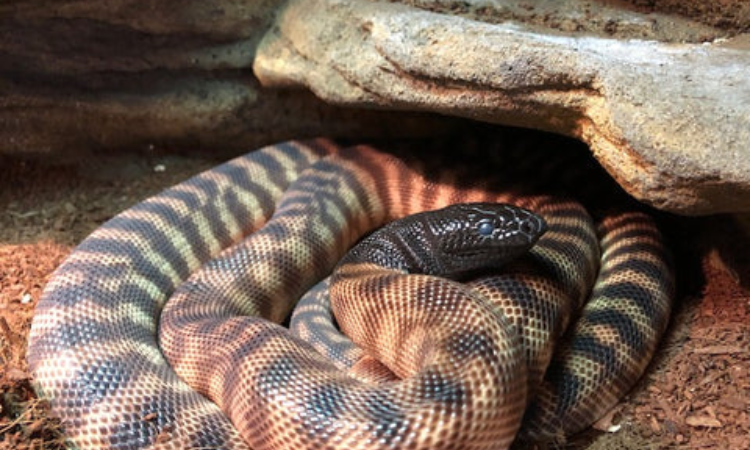How Large Do Black-Headed Pythons Typically Grow?: Has the spectacular development of Black-Headed Pythons ever captivated you? Join us on a twisted adventure as we figure out how these intriguing reptiles’ sizes have changed over the years.
The Unexplained Scattering of Black-Headed Pythons
There are fascinating dimensions and growth patterns in the world of Black-Headed Pythons. We can learn more about the secrets surrounding the average-size growth of these pythons by delving into the intricacies of their growth.
Analyzing the Size Spectrum for Varieties of Growth
A Black-Headed Python’s growth trajectory is complicated by the size spectrum it displays. These pythons can grow to be five to eight feet long on average. Due to the size variation within the species, every python is distinct and interesting in its way.
The Elements That Promote Growth: Understanding Nature’s Formula
A complex recipe is created by nature for the growth of the Black-Headed Python. Genetics, environment, and nutrition mainly dictate the trajectory of their growth evolution. Everything is moving in perfect synchronization with nature’s plan and the environmental canvas.
Fact-Checking: Differentiating Truth from Fiction
Many people have the wrong idea about how big pythons are. Despite their impressive appearance, Black-Headed Pythons are not as big as other python species. They don’t require a large size to thrive because their growth closely matches their natural niche.
The Life Cycle: From Foetus to Adult
The evolution of the Black-Headed Python is an intriguing story. They initially emerge from the egg stage at a length of 12–18 inches. The pythons’ inherent tenacity and natural wonders are on full display when one watches them grow into adults that can reach lengths of five or eight feet.
The Growth Equation for Presence, Frequency, Temperature, and Maximum Value
The growth equation for Black-Headed Pythons is made up of three variables: presence, frequency, and temperature. Factors such as temperature, the reptilian symphony of their environment, and the frequency of prey interactions determine their growth trajectory. Their incredible growth is due in part to a delicate equilibrium.

What is the frequency growth rate in frequency dancing?
The role of frequency is crucial in the evolution of black-headed pythons. Unlike certain species, Black-Headed Pythons do not experience sudden and extreme development spurts; rather, their growth pattern is steady and continuous. This symphony of frequencies will allow their size to evolve in harmony with their environment, ensuring a steady and sustained development.
Impact of Ecosystems on Growth Patterns
Their development is heavily influenced by the presence of Black-Headed Pythons. Their strong and consistent growth pattern is the result of their adaptability to many environments and their ability to thrive in different types of habitats. It demonstrates how they both prey on other animals and keep a delicate balance in their habitats.
Thermostat for Growth: Temperature
The temperature is the master regulator of the Black-Headed Python’s growth. The body temperature of these reptiles is affected by external causes since they are ectothermic. The small temperature changes in their environment have a major impact on the metabolic processes that drive their growth. Their subtle dance is orchestrated by temperature, which plays the role of a silent conductor.
A Serpentine Symphony of Natural Parallels
An intriguing perspective is often provided by natural analogies. Like a serpentine symphony, the evolution of Black-Headed Pythons is influenced by factors such as presence, frequency, and temperature. This similarity reminds us of the inherent complexity and beauty of these remarkable reptiles’ developmental paths.
Environmental Considerations: Balancing the Needs of a Growing Ecosystem
Understanding the Dark-Headed The fascinating dynamics of Python’s growth serve as both an investigation into the intricacies of reptile biology and a rallying cry for conservation efforts. Striking a balance between their growth and the health of their ecosystems is of the utmost importance. In addition to safeguarding these pythons, conservation efforts aim to maintain the ecological harmony in which they thrive.
Managing Cohabitation through Human Contacts
In their development, black-headed pythons often encounter human settlements. Responsible management of this cohabitation is of the utmost importance. Being knowledgeable about these incredible reptiles’ habits, growth patterns, and ecological roles can help us connect with them peacefully, reduce conflict, and develop a respectful relationship.
Storytelling about Size: The Survival Tale
The size of the Black-Headed Python is symbolic of its resilience, adaptability, and perseverance, rather than just a numerical value. The growth of these pythons, expertly weaved into natural patterns, reveals their ability to thrive in diverse environments, showcasing the wonders of evolutionary adaptation.
The Explosion of Development: Life-Changing Experiences
Despite appearances, there are moments of rapid development marked by explosiveness and critical occurrences. Bursts of growth, such as shedding old skin, reaching reproductive age, and establishing territories, increase the dynamic layers of the serpentine narrative of Black-Headed Pythons.
The Effect of Temperature on Behaviour: Beyond Growth
Temperature is a key variable in their growth equation and it also influences their behaviour. Insight into the complex web of life on Earth is enhanced by learning how temperature impacts their behavior, nutrition, and reproduction tactics. Their proliferation is not happening in a vacuum, but rather in direct relation to greater ecological dynamics.
In conclusion, the Serpentine Growth Tapestry
In conclusion, the evolution of Black-Headed Pythons is a multi-thread rug with intricate threads that stand for frequency, presence, and temperature. As we follow the pythons’ life cycle, it becomes more apparent that they are more than just huge animals; they are vital instruments in the ecological orchestra. Their story of growth makes us stop and appreciate the symphony of nature, where each note contributes to the eternal melody of life.
I hope you like the part where we talked about How Large Do Black-Headed Pythons Typically Grow. For more content like this, visit our website reptilein.com.

